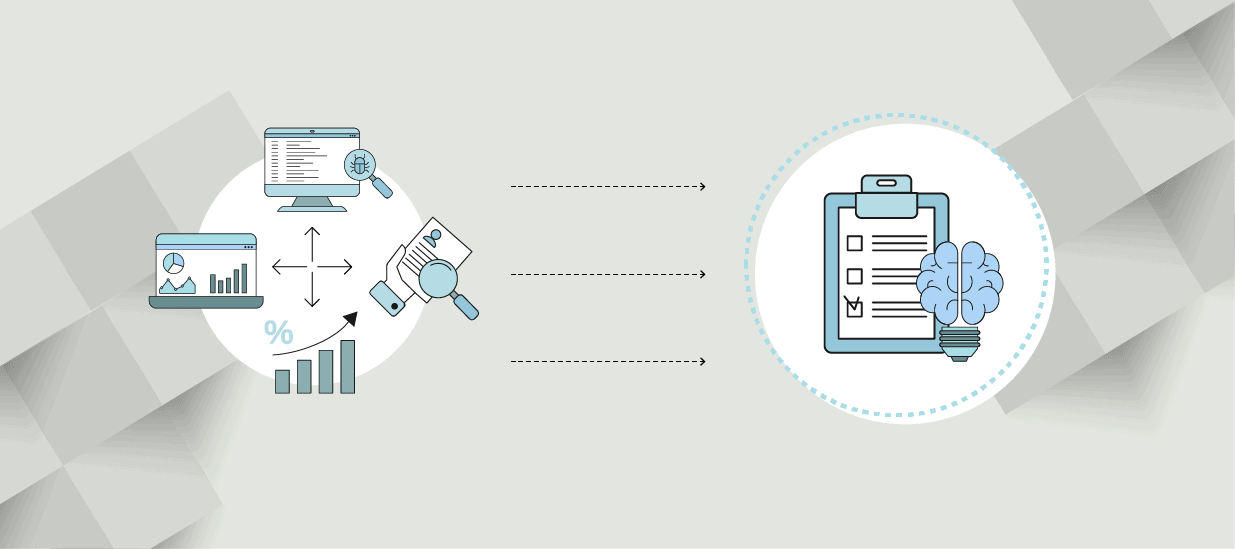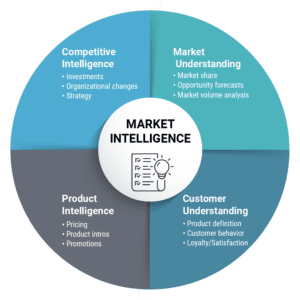4 minute read
Market intelligence is an essential way for businesses to gather market-wide insights and set business strategies. This comprehensive guide will explain how it’s defined, how it differs from other types of business intelligence, and how you can use it in your organization.
Key Takeaways:
- Market intelligence is the data companies gather to understand the market they are operating in. It is a type of competitive intelligence.
- There are 4 types of market intelligence: competitive intelligence, product intelligence, market understanding, and customer understanding.
- It differs from business intelligence because it focuses on the company’s external business environment. On the other hand, business intelligence focuses on the internal business environment.
What is Market Intelligence?
Market intelligence can be defined as data or information about the environment in which a company is doing business. This can include data collection and analysis, deriving insights, and sharing findings throughout an organization. It is relevant to the organization’s market segments and helps determine market segmentation and market opportunities.
What are the Types of Market Intelligence?
There are four primary types of market intelligence: competitive intelligence, product intelligence, market understanding, and customer understanding. Each type addresses a separate aspect of a business’s environment.
- Competitive Intelligence: Data on your competitor’s strengths, weaknesses, position in the market, and business strategies. It also helps you create strategies to boost your competitive advantage.
- Product Intelligence: Data on the lifecycles of your products and competitors’ products. This includes tracking product development, pricing, and performance. This helps your business innovate products to meet changing market needs.
- Market Understanding: Data on the broader market in which your business sits. Market understanding may include assessing overall market size, growth rate, trends, and market segments, and larger trends that may drive changes in your market. This is a 1000-foot view of your market. Market understanding helps your business identify opportunities and threads and adjust your strategies.
- Customer Understanding: Data to help you deeply understand your customers’ attitudes, behaviors, needs, and satisfaction. Customer understanding helps your business adapt products and offerings to meet customer needs, which boosts customer loyalty in the long term.
These four types of intelligence can help you gather data about your product and about your company’s market position.
What is the difference between market intelligence and business intelligence?
Market intelligence and business intelligence are similar concepts, and so are often confused. Both types of intelligence are essential to making strategic business decisions. However, they are different because they focus on different types of data.
Market intelligence focuses on the business’s external environment. This requires you to gather and analyze information about the larger market (at a 1000-foot view). This might include information about your competitors, customers, trends, and products in the market. This takes an outside-in approach to gather information from outside of your company to help drive business decisions.
Business intelligence focuses on the business’s internal environment. This requires you to gather and analyze internal business data about sales, finances, production, and operations.
Both types of intelligence are important because they help you make informed decisions about business strategy. Although they differ in their focus and scope, businesses perform best when they use these types of intelligence together.
How does it differ from competitive intelligence?
Competitive intelligence has a narrower scope. Competitive intelligence focuses on data related to your competitors’ products, market share, and business strategies. This allows you to look at specific competitor activities rather than at the market overall. It includes competitor intelligence and has a broader scope that allows your business to look beyond just your competitors. This looks at market trends, customer needs, product insights, and competitor strategies.
How do you use Market Intelligence?
Market intelligence plays a crucial role in helping your business grow and thrive in your market. It can guide processes that determine the success or failure of a product or business.
- Decision Making. Gathering market data gives you the facts you need to make data-driven decisions about product development, design, pricing, marketing, and more.
- Competitive Advantages. Data about your overall market can give your company a competitive edge. Understanding your customers’ needs and preferences, as well as what your competitors are doing (or not doing), helps you stay ahead of the competition.
- Identifying unmet customer needs and flagging pain points in the market helps you develop products that stand out in new market segments. This helps your business innovate products and grow your business.
How to Collect Market Intelligence
Conducting research involves gathering data from a variety of sources and methods. Using different types of data will give you a more holistic understanding of the market environment in which you are doing business. Gathering and analyzing the data, mining insights, and sharing key findings with supportive stakeholders can help set strategies and processes that will drive your business forward in the market.
Gather and Analyze Data
Data can come from a variety of sources, including surveys, customer interviews and focus groups, brand and social media monitoring, purchase and usage data, and more. Reputable companies like IDC can provide data on product shipments, competitor profiling, and other relevant market data. Businesses can also use internal teams such as purchasing, finance, and sales to gather competitor insights, customer feedback, and market trend data.
Uncover Insights from Market Intelligence Data
Once you gather your data, cleaning and analyzing it is essential to pull out actionable market insights for your business. Ensuring that your data was collected accurately is essential to extracting meaningful analyses (remember the “garbage in, garbage out” principle). Beyond data cleaning, rigorous data analysis will allow your business to merge data from different sources to identify trends and see cause-and-effect relationships between different market variables.
Share Your Findings
The ultimate test of research and analysis is whether it enables stakeholders to confidently make business decisions. For example, reporting to the executive team that a competitor is gaining market share is only marginally beneficial. Furthermore, when that report is combined with insights into the competitor’s product development priorities, sales, and changing customer needs, you can share the big-picture view of your market. That can instill confidence in the data and drive efficient and strategic decision-making.
A True-Life Example
In a recent assignment for a Fortune 500 technology company, I was challenged with turning a division-level marketing research organization into a world-class market intelligence group. By leveraging the talent within the team, investing in database development and automation, focusing on key executive information needs, and reaching across organizational boundaries to integrate many data sources, this division-level research team became the premier Market Intelligence organization for the corporation.
A few of the key actions that enabled this change are as follows:
- Ensuring that everyone on the team shares a common vision for what the Market Intelligence group should be, what it should deliver, and what are the key focus areas for improvement. It is important that the entire team is involved in this process and that they feel ownership of the results.
- Based on this, we created an actionable mission statement, aligned annual group objectives, and defined career development paths. As a result, the entire team was invested in the process and focused on achieving world-class status.
- We invested significant time and financial resources in building databases and tools to automate the analysis process. In fact, at one point, a single analyst spent about 6 months of full-time effort managing the development of these tools. This was a difficult investment to make since the team was already understaffed.
- Because we enabled these tools, we went from 3 staff members spending 80% of their time creating a quarterly global market share report to 1 staff member and 2 interns spending 50% of their time creating generating 42 highly segmented (and impactful) market share reports through the year. As a result of this significant productivity improvement, the team spends significantly more time developing customized executive reporting.
- Our team began hosting worldwide, cross-divisional summits for the marketing research and competitive analysis units within the corporation. These summits increased collaboration across teams and improved the flow of information and analysis.
- During and after this project, the team met with executives and internal clients to understand what information they needed, what they were not getting, and what was working well. This market team became the source of critical market information and supported company decision-making.
Over 3 years, this team evolved from an effective marketing research team to a world-class market intelligence organization, which is a model and resource for the entire organization. In fact, the team became so effective that they drove strategic corporate-level initiatives, such as developing a corporate-wide market-forecasting model.
Summary
Market intelligence gives you a perspective on your business’s position within the wider environment. By combining competitive intelligence, product intelligence, market understanding, and customer understanding, you can understand competitors, customers, and market trends.
Finally, markets are always changing. Businesses should create ongoing processes to gather data, derive insights, and communicate those insights internally. This approach can help you stay ahead of competitors and market trends.
Author
-

Ed Crowley, boasting 30+ years in Product and Brand Management, has made a mark in influential roles at companies like QMS, Texas Instruments, and Lexmark International. A seasoned keynote speaker at global events and prolific author, his expertise spans high-tech marketing, product strategy, and marketing intelligence. For questions or inquiries, please contact [email protected].
View all posts









